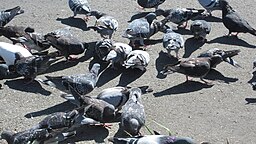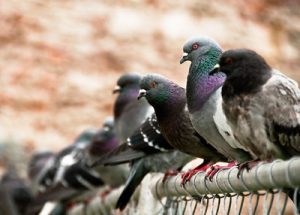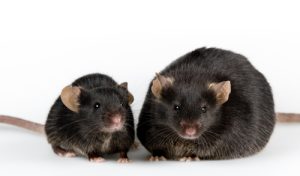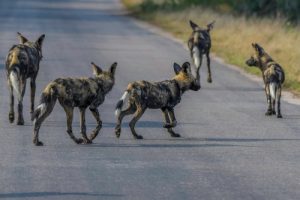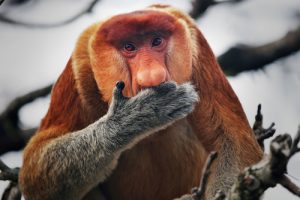The story of the sad exodus of the passenger pigeon
There’s a good chance you already know the story of the extinction of the dodo. However, do you know the comparable tale on the demise of the passenger pigeon?
The passenger pigeon was a species of pigeon that lived in the vast deciduous forests of Canada and North America. It was monotypic, meaning it was the only species of its genus. The name ‘passenger pigeon’ was bestowed by America’s indigenous people, referring to its remarkable migratory habits. During the cold winter months, the passenger pigeon would migrate in vast numbers to the warmer climes. Generally, this was America’s southern states or sometimes as far south as Mexico.
At the turn of the 19th century, some estimated the total population of the passenger pigeon at 5 billion. It is highly likely to be the most abundant species of bird that has ever existed on the planet. However, a combination of uncontrolled deforestation and a malicious hunting regime saw the bird’s rapid demise. The last passenger pigeon sighted in the wild occurred in 1900. The last known captive of the species was named ‘Martha’. The bird died, aged 29 years old, in Cincinnati Zoo in 1914. The stuffed Martha is now on display in the U.S. National Museum of Natural History.
The passenger pigeon was a highly sociable bird, similar in size to the European wood pigeon. Its diet consisted of nuts, berries, worms, and insects. However, its favoured sustenance was acorns and chestnuts, which were abundant in the vast deciduous forests of the USA.
A Living Relative
A little larger than the mourning dove, the passenger pigeon was also similar to it in appearance. Thus, the dove was once considered to be its closest living relation. However, recent genetic analysis has found the passenger pigeon’s nearest relative is, in fact, the band-tailed pigeon. A bird that is common to the West coast of the USA, Central America, and Argentina.
The immensity of the migratory passenger pigeon flocks was reported as being beyond imagination. On one occasion, a single migratory flock was estimated to be around 2 billion birds. It would seem the extremely companionable nature of the birds was at least one reason why they travelled in such huge flocks. According to some testimonies, flocks were so immense they darkened the sky for several days at a time by blocking out sunlight. An observer estimated the size of a single flock of migrating birds was 300 miles in length and at least a mile wide.
The birds had always been a readily available source of food for native Americans. This also continued to be the case for America’s early 17th-century settlers. As time progressed, immigration to America accelerated, and consequently, so did the problems for the passenger pigeon. The immense forest habitats which the pigeon needed to survive were rapidly devastated by settlers to make way for agricultural development. Thus, the passenger pigeon quickly became viewed as a pest.
The Start of the Decline
The notable decrease of passenger pigeon numbers started in the early 1800s. This is when professional hunters began to pursue the birds in large numbers to sell on to market traders. Naturalist and artist, John James Audubon’s classic book ‘The Birds of America’, was first published in 1827. He wrote, “The pigeons were picked up and piled in heaps until each [hunter] had as many as he could possibly dispose of, when the hogs were let loose to feed on the remainder.”

There were no laws restricting the number of pigeons that could be killed or any bans on the method of hunting. Because of the bird’s tendency to nest in vast communities, they proved to be easy pickings for merciless hunters. The hunters employed all available methods to trap their prey, including the use of gas to paralysis the birds. The method involved producing sulphur fumes from a boiling pot that was placed at the base of a tree. The fumes would simply daze the roosting birds, causing them to fall to the ground.
By the 1850s the devastation of the passenger pigeon was in full swing. By the 1860s it was obvious that the numbers of the birds were decreasing, yet the slaughter continued. By the end of the American Civil War in 1865, railroads had begun to penetrate the upper mid-west. This facilitated the clearing of hundreds of thousands of acres of virgin forest and the bird’s extermination.
The End Game
The end game for the passenger pigeon was to come with astonishing rapidity. Petoskey, Michigan, was one of the last strongholds of the passenger pigeon. In 1878, their nesting sites were penetrated by hunters, who allegedly killed 50,000 birds per day for a period of almost five months. Such devastation saw concerned voices of conservationists raised. However, this had little effect on stopping the slaughter. A law was eventually passed in Michigan, making it illegal to net pigeons within two miles of a nesting area. However, the law was poorly enforced and few arrests were ever made for violations.
By the early 1890s, the passenger pigeon had almost completely disappeared. In 1897, a new protection bill was introduced in Michigan. It asked for a ten-year closed season on the killing of passenger pigeons. However, a completely futile gesture, it was already far too late to protect the bird. The surviving passenger pigeon numbers had already dropped below the critical threshold. Numbers were already too low to re-establish the species.
A Bizarre Exodus
Mass hunting of the passenger pigeon only came to an end when it proved no longer economically viable. That point was reached when there were still tens of thousands of birds and large expanses of suitable habitat. Why some birds did not survive in the more remote areas of their habitat is still not fully understood. Paradoxically, much of that same habitat still exists today.
We know that the passenger pigeons were slaughtered on an unprecedented scale. However, the rapid demise of the species from billions to zero in the relatively short time span of fifty years still very much baffles experts. As extinctions go, the passenger pigeons’, has been described as the ‘mother’ of them all.
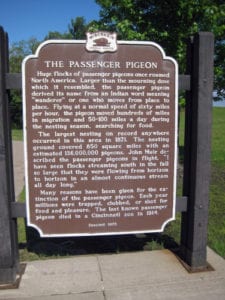
Commemorative plate to the passenger pigeon – Black River Falls, Wisconsin.
Was the answer in the passenger pigeons’ demise in its genetics? No one knows for sure! One of the predominant theories was that the passenger pigeon needed to nest in vast colonies in order to survive. The passenger pigeon undoubtedly proved to be easy pickings for its natural predators. However, numbers were so huge, birds lost this way would have been insignificant. Ecologists have been looking for answers to the passenger pigeon’s downfall for more than century but are we any nearer to the answers?
Recent Studies
In a study published in 2014, researchers sought to understand how such a profuse species could possibly be driven to extinction. It was found that despite the huge population of the passenger pigeon, the bird was much less genetically diverse than expected. The study suggested numbers were not always super-abundant. It was theorised that populations had either exploded relatively recently or could fluctuate naturally by a thousand-fold or more within short time spells. The phenomenon is seen with other creatures such as locusts and lemmings.
The study concluded that the passenger pigeon was an “outbreak species” and that huge periodic population crashes were a natural phenomenon. It was cited that the passenger pigeon’s population was already in a natural decline when European immigrants and colonists came along. The bad timing of this event meant that the species was pushed over the edge into extinction.
A 2018 study by the Department of Ecology and Evolutionary Biology at the University of California, Santa Cruz led by Dr Beth Shapiro, challenged that conclusion. The Report agreed the passenger pigeon had a surprisingly low genomic diversity compared to the overall size of its population. While some regional variation of the pigeon’s genomics was found in some sample species there was none found in others.
Researchers reasoned that if the passenger pigeon’s population had been wildly fluctuating by many multiple times over long periods of time, then the overall genetic diversity of the birds should be equal across all populations. Contrary to the premise, the research found that the bird’s population had been stable for at least the past 20,000 years. The time period included dramatic climatic changes, precisely when it could be expected to see large population fluctuations.

The other theory mooted by researchers for the pigeon’s unusually low level of genetic diversity was natural selection. It was that the process of natural selection acting on one particular gene could result in a loss of diversity amongst nearby genes, or those genes that are somehow connected to the selected gene – a phenomenon cited in the study as the “hitch-hiking effect”. The Report concluded that the passenger pigeon’s genomic make-up did show a “hitch-hiking effect” of strong natural selection.
The research went on to look at the closest living relative to the passenger pigeon, the band-tailed pigeon for possible answers. Although the two species were the closest of relatives and biologically similar, the big difference important to the study was that the band-tailed pigeon’s population had always been much smaller than that of the passenger pigeon.
The Expert Opinion
The 2014 and 2018 studies ended up with completely different answers on why the passenger pigeons met its demise. Neither, it would seem, have provided any further insight into why the passenger pigeons’ rapid extinction happened than was already known. It appears that none of the published research to date has answered even some of the more basic lingering questions, like; ‘‘How many passenger pigeons would have been needed to be kept alive to sustain an enduring population?’’ or ‘’Was the passenger pigeon a totally unique ecological case?’’
The 2018 Santa Cruz University study showed that passenger pigeons had adapted remarkably well to living in mega populations. Professor Shapiro elaborated in an email, “In large populations, natural selection is highly efficient. This suggests that if the environment had changed slowly (as it may have after the end of the last ice age) they would be able to adapt to these changes (as they did at the end of the last ice age).”
Professor Shapiro further wrote on the pigeons’ demise; “There was no time at all for passenger pigeons to adapt to this new environment. They did not die because they had very little diversity …… but because they suddenly found themselves living in an environment that was very different from the one to which they were adapted, still being overexploited by a highly skilled predator, and now lacking an efficient means to evolve in response to this environmental change.”
The Santa Cruz research suggests that the passenger pigeon lacked the necessary genetic resources to adapt their physiology and behaviour quickly enough to live in the smaller communities, which became necessary following the human invasion of its habitat. And this in part, stemmed from the birds’ lack of genetic diversity that was necessary to make that happen. The passenger pigeons’ homogeneous genetic make-up would have obviously also made it much more susceptible to potential wipe-out from a killer disease. However, there appears to be even a hint of this possibility ever being mooted in any past research.

However, genetics are now considered to be only part of the story of the passenger pigeon. Based on past reports, researchers are confident that the passenger pigeon was behaviourally adapted to living in large communities. It’s known that they collaborated in finding food and in rearing young. While such things which might work very well in large and dense populations, it’s recognised that the effect of being hunted by a large and sophisticated predator like man, would have especially devasting.
Have any lessons been learnt from the unparalleled catastrophic extinction of the passenger pigeon? In the past, biologists have generally assumed that a large population corresponds to a high genetic diversity and that this would normally act as a buffer against extinction. However, the extraordinary story of the passing of the passenger pigeon serves as a cautionary tale that this assumption cannot always be held true.
Professor Shapiro opined, “There’s more that we should consider when we think about a population being endangered than just population size,”. She pointed out that it’s now realised successful conservation efforts may require decisive action long before a given species’ population falls below supposed critical levels.
De-extinction
It is well documented that human impact on our planet has reduced many wildlife populations to a precarious state. As in the case of the passenger pigeon, this has caused the complete extinction of some species. However, with the emergence of better genetic understanding from ongoing research, the possibilities of genomic conservation are rapidly emerging.
Such a programme of research is currently being carried out on the passenger pigeon by the Revive & Restore Organisation, based in Sausalito, California. Professor Beth Shapiro from Santa Cruz University is the leading Project Advisor. A project spokesperson has said it will be impossible to recreate an identical copy of the historic passenger pigeon because DNA specimens are just too fragmented. However, it will be still possible to create a bird that has the passenger pigeon’s most important traits.
The de-extinction programme aims to re-establish passenger pigeon traits into its nearest living relative, the band-tailed pigeon. This is an iterative process that begins with identifying candidate passenger pigeon gene variants to edit into the genome of the band-tailed pigeon. Most of the mutations between the two species that have built up over time can for the purposes of de-extinction be ignored. To recreate the ecology of the passenger pigeon the mutations are not important. The process involves introducing the smallest possible number of mutations necessary to recreate the passenger pigeon’s ecology.
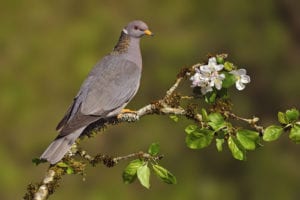
Band-tailed Pigeon is closest relative of the Passenger Pidgeon
From an evolutionary standpoint, passenger pigeon de-extinction creates a new lineage of creation, a lineage originating from the band-tailed pigeon but carrying the genes of the extinct passenger pigeon. Currently, there is no scientific consensus on what constitutes a new species. Thus, the new passenger pigeon would be considered an ‘ecotype’ rather than a new species or hybrid. An ecotype has been described as ‘’a genetically distinct population of a species inhabiting a specific geographic range, which exhibits a uniquely adapted ecology.’’
By introducing passenger pigeon genes to the band-tailed pigeon the process of adaptation to take on the role of the passenger pigeon is being facilitated. It is hoped that in the future large dense band-tailed pigeon flocks will mimic those of the passenger pigeon of the past.
The Revive & Restore de-extinction programme is working towards hatching the first generation of passenger pigeons by 2022. The goal is to release the first test flocks sometime between 2030 and 2040. The eventual target is to reach self-sustaining population growth which is projected to need at least 10,000 birds in the wild. The wild population will be regularly stocked until it appears to be self-sustaining. It’s estimated that may be possible within twenty years.
